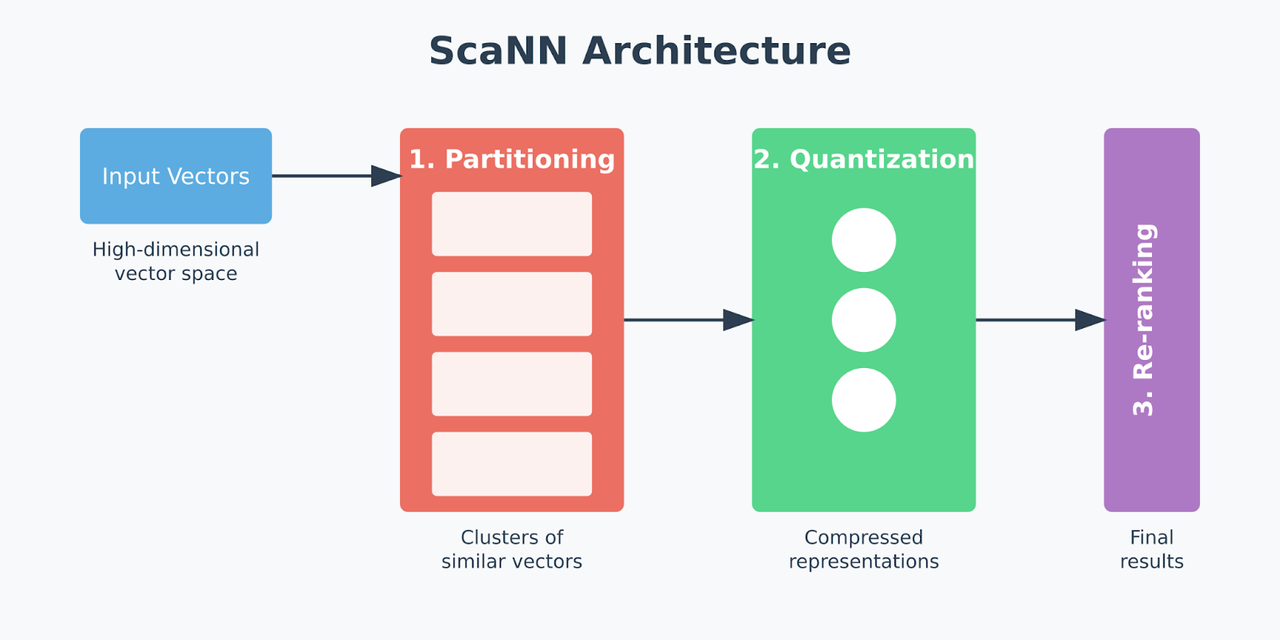SCANN
Powered by the ScaNN library from Google, the SCANN index in Milvus is designed to address scaling vector similarity search challenges, striking a balance between speed and accuracy, even on large datasets that would traditionally pose challenges for most search algorithms.
Overview
ScaNN is built to solve one of the biggest challenges in vector search: efficiently finding the most relevant vectors in high-dimensional spaces, even as datasets grow larger and more complex. Its architecture breaks down the vector search process into distinct stages:
 Scann
Scann
Partitioning: Divides the dataset into clusters. This method narrows the search space by focusing only on relevant data subsets instead of scanning the entire dataset, saving time and processing resources. ScaNN often uses clustering algorithms, such as k-means, to identify clusters, which allows it to perform similarity searches more efficiently.
Quantization: ScaNN applies a quantization process known as anisotropic vector quantization after partitioning. Traditional quantization focuses on minimizing the overall distance between original and compressed vectors, which isn’t ideal for tasks like Maximum Inner Product Search (MIPS), where similarity is determined by the inner product of vectors rather than direct distance. Anisotropic quantization instead prioritizes preserving parallel components between vectors, or the parts most important for calculating accurate inner products. This approach allows ScaNN to maintain high MIPS accuracy by carefully aligning compressed vectors with the query, enabling faster, more precise similarity searches.
Re-ranking: The re-ranking phase is the final step, where ScaNN fine-tunes the search results from the partitioning and quantization stages. This re-ranking applies precise inner product calculations to the top candidate vectors, ensuring the final results are highly accurate. Re-ranking is crucial in high-speed recommendation engines or image search applications where the initial filtering and clustering serve as a coarse layer, and the final stage ensures that only the most relevant results are returned to the user.
The performance of SCANN is controlled by two key parameters that let you fine-tune the balance between speed and accuracy:
with_raw_data: Controls whether original vector data is stored alongside quantized representations. Enabling this parameter improves accuracy during re-ranking but increases storage requirements.reorder_k: Determines how many candidates are refined during the final re-ranking phase. Higher values improve accuracy but increase search latency.
For detailed guidance on optimizing these parameters for your specific use case, refer to Index params.
Build index
To build a SCANN index on a vector field in Milvus, use the add_index() method, specifying the index_type, metric_type, and additional parameters for the index.
from pymilvus import MilvusClient
# Prepare index building params
index_params = MilvusClient.prepare_index_params()
index_params.add_index(
field_name="your_vector_field_name", # Name of the vector field to be indexed
index_type="SCANN", # Type of the index to create
index_name="vector_index", # Name of the index to create
metric_type="L2", # Metric type used to measure similarity
params={
"with_raw_data": True, # Whether to hold raw data
} # Index building params
)
In this configuration:
index_type: The type of index to be built. In this example, set the value toSCANN.metric_type: The method used to calculate the distance between vectors. Supported values includeCOSINE,L2, andIP. For details, refer to Metric Types.params: Additional configuration options for building the index.with_raw_data: Whether to store the original vector data alongside the quantized representation.
To learn more building parameters available for the
SCANNindex, refer to Index building params.
Once the index parameters are configured, you can create the index by using the create_index() method directly or passing the index params in the create_collection method. For details, refer to Create Collection.
Search on index
Once the index is built and entities are inserted, you can perform similarity searches on the index.
search_params = {
"params": {
"reorder_k": 10, # Number of candidates to refine
}
}
res = MilvusClient.search(
collection_name="your_collection_name", # Collection name
anns_field="vector_field", # Vector field name
data=[[0.1, 0.2, 0.3, 0.4, 0.5]], # Query vector
limit=10, # TopK results to return
search_params=search_params
)
In this configuration:
params: Additional configuration options for searching on the index.reorder_k: Number of candidates to refine during the re-ranking phase.
To learn more search parameters available for the
SCANNindex, refer to Index-specific search params.
Index params
This section provides an overview of the parameters used for building an index and performing searches on the index.
Index building params
The following table lists the parameters that can be configured in params when building an index.
Parameter |
Description |
Value Range |
Tuning Suggestion |
|---|---|---|---|
|
Whether to store the original vector data alongside the quantized representation. When enabled, this allows for more accurate similarity calculations during the re-ranking phase by using the original vectors instead of quantized approximations. |
Type: Boolean
Range: Default value: |
Set to Recommended: Use |
Index-specific search params
The following table lists the parameters that can be configured in search_params.params when searching on the index.
Parameter |
Description |
Value Range |
Tuning Suggestion |
|---|---|---|---|
|
Controls the number of candidate vectors that are refined during the re-ranking phase. This parameter determines how many top candidates from the initial partitioning and quantization stages are re-evaluated using more precise similarity calculations. |
Type: Integer Range: [1, int_max] Default value: None |
A larger Consider decreasing In most cases, we recommend you set a value within this range: [limit, limit * 5]. |